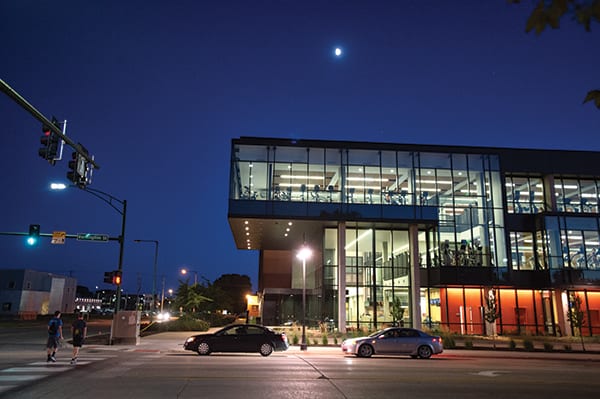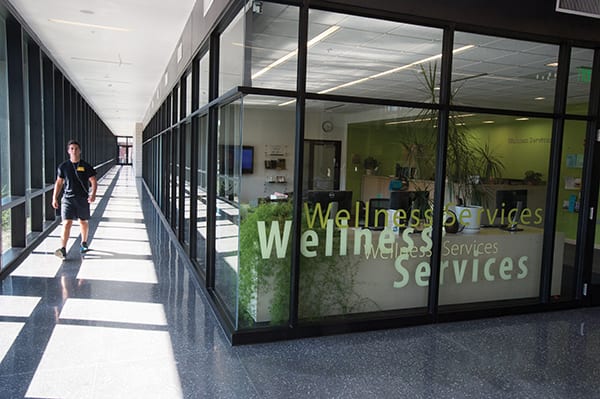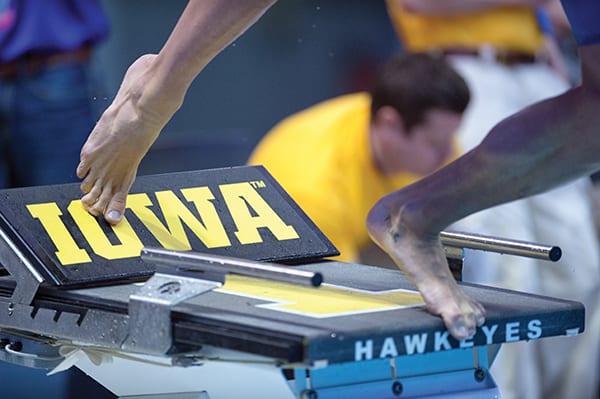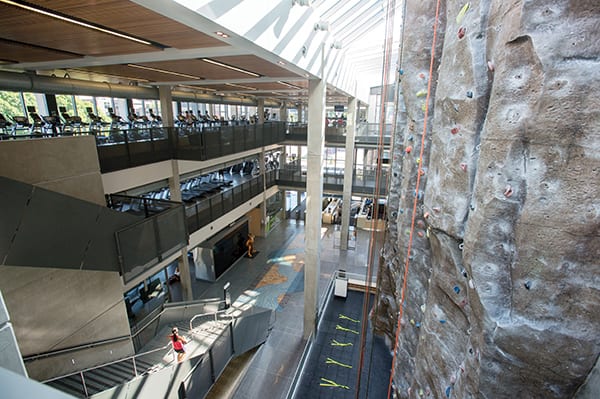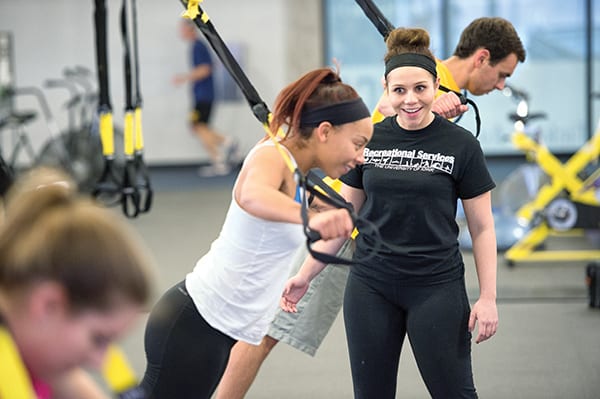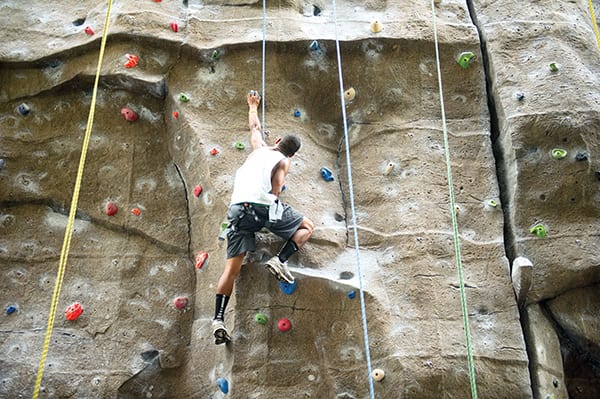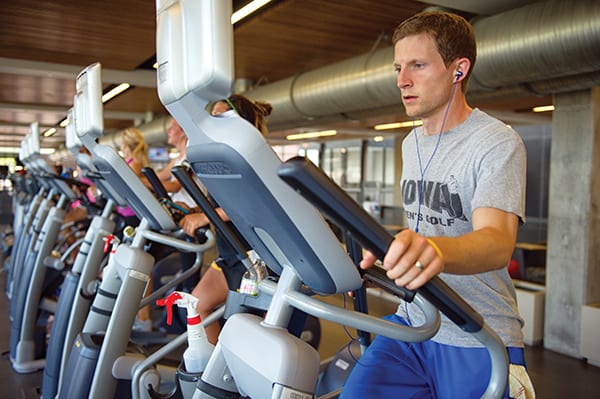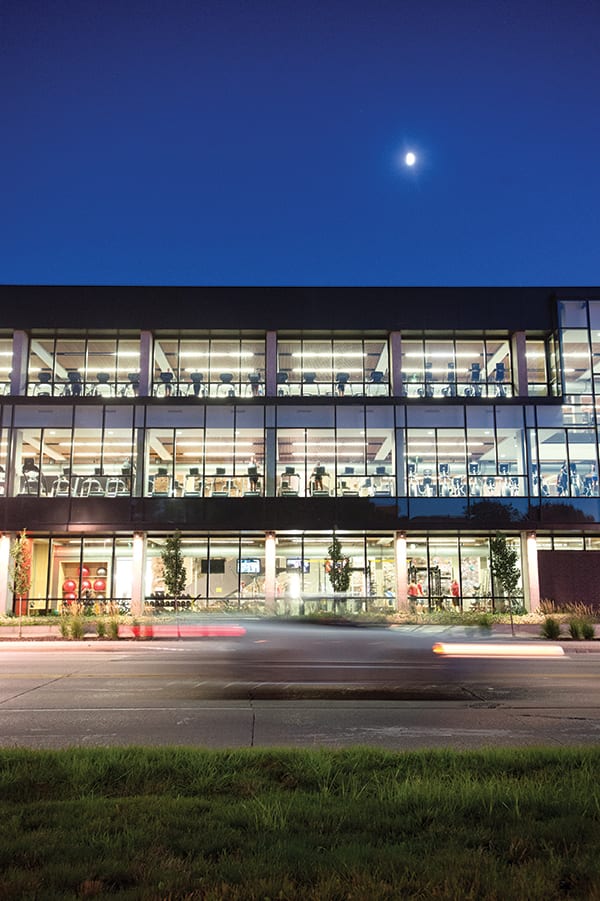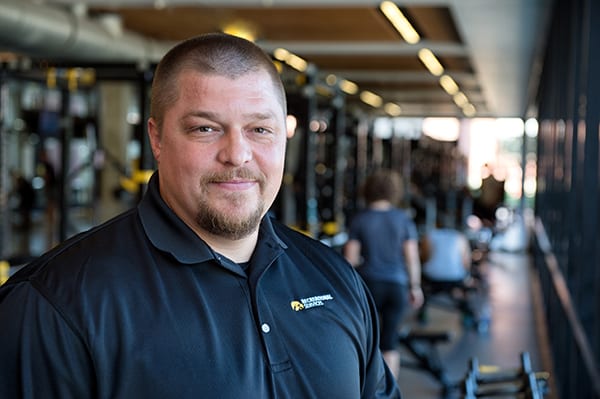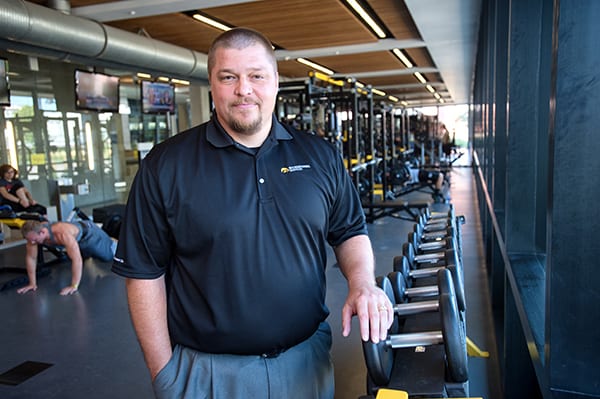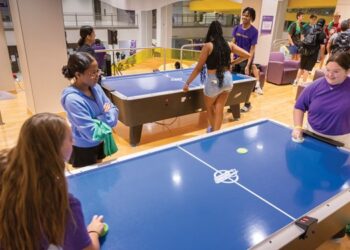Late one evening, when all is quiet on campus, a lone soccer ball smashes into a sprinkler head causing it to spill 600 gallons of water onto the fine, maple floors in one of the several recreation buildings on the University of Iowa campus.
When JT Timmons, director of recreational services, should have been relaxing at home, he is called to campus to assess the damage. However, it is situations like these that Timmons says make his job exciting. Something is always presenting a new and complex challenge.
“One of the things that I really like about recreation is it does not get monotonous,” said Timmons. “There is a level of structure where meetings get scheduled with my staff, but there is also some spontaneity. Because we manage multiple facilities, my staff is scattered across campus, so I have to be a little bit more mobile. I like to be visible anyways. I don’t just sit at my desk.”
This is probably a common theme for most recreation directors. In an ever-changing industry, it is essential to stay on your toes. This is exactly what the University of Iowa Recreational Services has done, continuously adapting and evolving with the needs and desires of the student body.
Over the last five years, the department has experienced numerous significant changes. One of the most recent and extensive developments being the construction of the new Recreation and Wellness Center in 2010, followed by the retirement of Harry Ostrander, who served as the director of recreational services for over 44 years.
While these changes have presented certain challenges, the commitment to maintaining one of the best collegiate recreation programs in the country has remained consistent. This is one of the reasons Timmons was drawn to the program three years ago.
After serving as the director of recreation at the University of Illinois Springfield, Timmons was looking for a new opportunity. “I talked to some of my colleagues and mentors. I really felt that I needed to throw my name in the ring just to see what happened,” explained Timmons. “This type of position, at a program that is one of the top in the country, does not come around often. So I threw my name in and the rest is history.”
Filling Ostrander’s shoes was no easy task. Timmons explained the transition was one of the biggest challenges, but has also been one of the most rewarding experiences.
“Anytime there is a change, people are going to be hesitant,” added Timmons. “The most important thing when moving through the transition was to be transparent with people. I am going to share what I can when I can, make myself approachable and develop an environment in which trust is the foundation. A large staff is not always going to agree on every decision, but we need to have an environment where ideas and opinions can be put on the table and tossed around.”
While Timmons was not present during the initial construction of the new Recreation and Wellness Center, he explained watching the building come to fruition and fulfill its mission has been a highlight of the job.
According to Michelle Harder, the senior associate director of recreational services, when the Recreation and Wellness Center was built in 2010, it was a much-needed addition. “We weren’t keeping up with just the field house,” said Harder. “The field house is a great facility, but it was old. It was built in the 1920s. We were finding that the top one or two reasons students choose a campus is because of the student rec centers and the rec programs. We felt we were falling behind.”
Prior to starting construction, the department conducted numerous assessments with various groups on campus to get a better understanding of what each wanted in a new recreation center. “We met with faculty groups, student groups, the sports management program and many other groups on campus,” said Harder. “We had tons of meetings and we asked everyone what they were wanting out of a new facility. We figured out the demand was there from the students — they wanted a new facility. They wanted a ‘wow’ building, a place that was the showcase of the university.”
The 215,000-square-foot Campus Recreation and Wellness Center, which spans an entire city block, now serves as the hub of campus. The state-of-the art facility includes 20,000 square feet of fitness space, a 52-foot climbing wall, a jogging track, two basketball courts, multi-activity gym, a café and locker rooms.
“When you walk on campus, you see it. It is definitely a facility that people notice,” added Harder. “Our staff also does a great job with the programs. Everything we offer, from the outdoor programs, to the intramurals, to fitness and tennis, we listen to the patrons, get their feedback and look to see how we can improve.”
Another standout feature of the center is the diverse offering of aquatic programming. Students, faculty and community members can relax in the leisure pool that features a 25-person spa, a Vortex and a current channel, or they can swim laps in the 50-meter competitive pool.
“With the natatorium, we hosted several major events this spring, including the NCAA Swimming and Diving National Championships,” said Timmons. “That was an opportunity that this amazing space was able to bring to not only the campus and bring some publicity to our department, but to really boost the entire local economy.”
The Recreational Services department has made it a priority to provide students, faculty and staff with extensive recreational programming and stunning facilities. They are also making an enormous effort to address wellness on campus by partnering with UI Wellness.
When the Recreation and Wellness Center was constructed, a Wellness Suite was built on the first floor. “I think it is starting to be a trend, where wellness, health and recreational services are starting to combine, trying to collaborate and partner a bit more,” added Timmons. “What I am seeing is some of these newer facilities are starting to incorporate some of these features together.”
Through the Wellness Suite, students, faculty and staff have access to a wide variety of services, such as health screenings, online programs, health fairs, nutritional counseling, sexual health awareness and stress management services.
“We know there is a great deal of time that students spend outside of the classroom,” explained Timmons. “It is our responsibility to supplement everything that goes on in the classroom. If you look at health and wellness, we are trying to instill healthy choices so they become healthy habits, which become healthy lifestyles.”
Both the UI Wellness and Recreational Services departments recognized the importance of providing support and services to not only students, but to University of Iowa employees as well.
Faculty and staff are encouraged to join the Recreation and Wellness Center through the membership incentive program. For a small monthly fee, employees gain access to the recreation center. If they scan into the facility four or more times a month, human resources will reimburse half the membership cost.
“The reimbursement that they get comes from human resources. My department still keeps the full membership fee,” said Timmons. “From a financial standpoint, it is proven return on investment for the university. They are willing to subsidize it, and not at the expense of our department. We still maintain that full amount, which allows us to continue to do great things with the facilities, equipment and service offerings.”
According to Joan Troester, the interim assistant vice president of benefits, health and productivity for University Human Resources, the department is supportive of healthy campus culture. “We believe that providing these programs and services helps contain costs relative to our health care utilization,” she said. “By keeping people healthy over the long term, we are able to better manage health costs. But, most importantly, we are able to improve our employee performance through improved health and well-being.”
When it comes to launching new programs and services, such as the membership incentive program for employees, Troester explained the importance of doing research beforehand. “We run pilot programs initially if we are going to try something new,” explained Troester. “We are very diligent in the planning efforts to make sure we are taking into consideration all of the things we need in order to have a successful implementation. Then we are very focused on collecting outcomes and being able to demonstrate the value of these programs.”
The partnership between UI Wellness and Recreational Services has certainly provided tremendous value to both departments and the university as a whole. The Recreational and Wellness Center now serves as a one-stop-shop for all student and employee health and wellness needs.
“Rec Services has done an awesome job to really make sure health and wellness is something very visible on campus,” said Megan Hammes, the interim director of UI Wellness. “When you drive down our main road, you see people exercising through the windows of the recreation center. We have also created this culture of when you come to work at the university, you know they encourage everyone to be healthy and active. It creates a positive workplace.”
With ambitious enrollment goals, expansion is on the horizon yet again for the Recreational Services department. Timmons and his staff have big plans for the future. Even though the Campus Recreation and Wellness Center just opened five years ago, the department is already working on an addition to the facility.
“We are having a kickoff meeting to start work on the feasibility study for that phase,” explained Timmons. “Depending on how that goes, it may be one large project that duplicates the size of the existing facility. We have our eyes on the entire block to the south. I am very excited that we are able to get that project moving.”
Even with all of the various changes that have occurred over the past few years, and will continue to take place in the future, Timmons has faith that with the help of his team, the University of Iowa recreational programs will remain on top. “We have some very amazing people who do great work,” he said. “It is a team effort, we get it done together and we are always willing to help each other out.”



